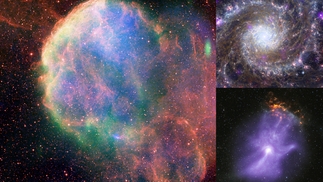Mysterious radio signal from distant galaxy detected by astronomers
The bursts last up to three seconds and occur every 0.2 seconds — the longest ever recorded, in the clearest periodic pattern ever observed.

A radio signal emanating from a distant galaxy several billion lightyears from Earth has been detected by astronomers in Canada and at the Massachusetts Institute of Technology (MIT).
As MIT reports, the anomaly takes the form of a Fast Radio Burst (FRB), essentially an intensely strong set of radio wave blasts. Usually, these are picked up for a few milliseconds at a time. In this instance, the FRB lasts up to three seconds, and occurs every 0.2 seconds, essentially presenting what has been described as a “clear periodic pattern”.
Scientists have labelled the signal FRB20191221A, and have stated that it is the longest FRB ever detected, and has signs of the clearest periodic pattern ever witnessed. Although the galaxy the signal has come from has been identified, the precise source therein is still unknown, although experts believe the most likely candidates are a radio pulsar or magnetar — two types of neutron star formed when stars larger than the sun supernova, blowing off their outer layers to leave a small, dense core that continues to collapse. The gravitational force involved is so strong the protons and electrons combine to form neutrons.
“There are not many things in the universe that emit strictly periodic signals,” said Daniele Michilli, a postdoctoral researcher at MIT’s Kavli Institute for Astrophysics and Space Research in a statement. “Examples that we know of in our own galaxy are radio pulsars and magnetars, which rotate and produce a beamed emission similar to a lighthouse. And we think this new signal could be a magnetar or pulsar on steroids.”
In addition to observations in Massachusetts, the signal has also been detected by the Canadian Hydrogen Intensity Mapping Experiment (CHIME), a radio telescope located in British Columbia, which studies the skies for radio waves that may have been emitted during the early stages of the universe. FRBs are not part of the research, but hundreds have been picked up in the past five years.
It's far from the first mysterious signal to have been picked up from a galaxy far, far away in recent times. An unknown object was found to be blasting out radio waves in January this year, just months before NASA released its audio recording of a black hole, and the Breakthrough Listen Project picking up a strange radio wave at the height of the pandemic.





